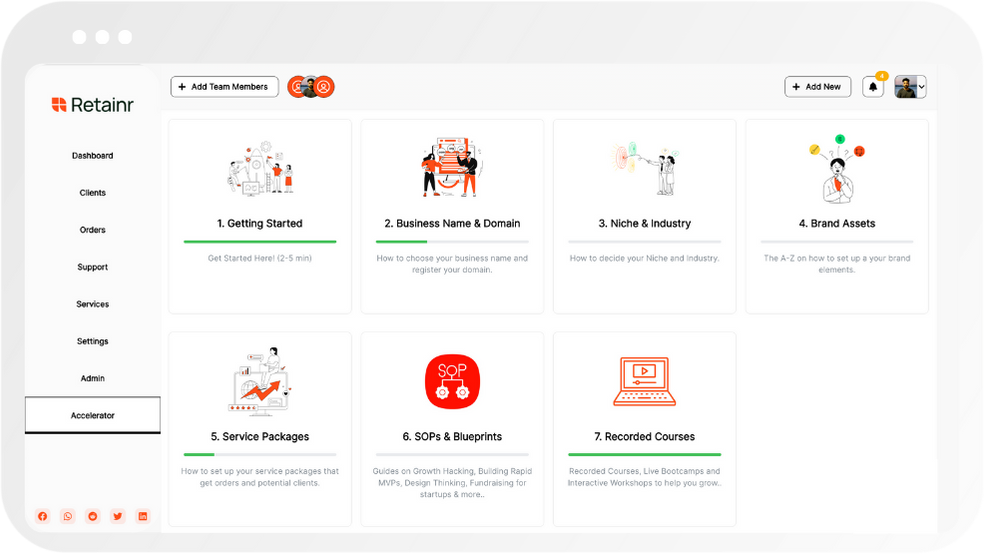
6 Expert Tips for Pinpointing Your Target Industry
Build with Retainr
Sell your products and services, manage clients, orders, payments, automate your client onboarding and management with your own branded web application.
Get Started1. What does it mean to pinpoint your target industry?
Understanding Pinpointing Your Target Industry
Being well-acclimated with the concept of 'pinpointing your target industry' is vital for every entrepreneur and business visionary. It involves identifying the specific industry or sector under which your products or services can flourish, focusing your marketing and business operations efforts towards it. This process helps in the progress of your business; it enhances your understanding of your potential customers and the market environment.
Significance of Pinpointing Your Target Industry
There are several reasons that elucidate the significance of pinpointing your target industry:
- Resource Optimization: It aids in the proper utilization of resources by focusing your time, finances, and other valuable assets into a chosen sector.
- Marketing Efficiency: It boosts your marketing strategies since your marketing efforts are directed towards a specific audience.
- Competitive Advantage: It assists in gaining a competitive advantage because you understand the industry norms, trends, opportunities, and threats better.
Visual Representation of Pinpointing Your Target Industry
Below is a simple table that depicts a hypothetical situation of a company deciding its target industry:
| Product/Service | Potential Industries | Selected Target Industry |
|---|---|---|
| Eco-friendly footwear | Fashion, Retail, E-commerce, Environmental Conservation | Fashion |
In this instance, the company manufactures eco-friendly footwear. Several industries could benefit from this product, such as fashion, retail, e-commerce, and environmental conservation. However, the company decides to target the fashion industry as it presents the most potential. This demonstrates the importance and procedure of pinpointing the target industry.
2. What are some expert tips for identifying the target industry for my business?
Understanding Your Business Model
Before you can identify your target industry, you need to have a comprehensive understanding of your business model. This includes understanding your product or service, your competitors, and your unique value proposition. Here are some key points to consider:
- Product or service: What do I offer? How is it different from what others offer in the market?
- Competitors: Who are they, and what are their strengths and weaknesses?
- Value proposition: What makes my product or service unique?
By understanding these elements, you can better identify which industry your business belongs to. For example, if your product is a mobile game app, your industry could be 'Mobile Gaming.'
Research the Market Landscape
Once you have a clear understanding of your business, you can begin researching the market landscape. This includes looking at market trends, customer behaviors, and key competitors. Here are some approaches:
- Market trends: Use tools such as Google Trends to learn about recent developments in your potential industry.
- Customer behavior: Survey potential customers or use market research reports to understand their preferences and behaviors.
- Competitor analysis: Identify your key competitors in the industry and analyze their strengths and weaknesses.
Analyze Data to Pinpoint Your Industry
Finally, after gathering this information, you can analyze it to pinpoint your target industry. This can involve looking at data trends to identify the most promising markets and understanding where your business fits within the broader industry ecosystem. Consider the following:
| Data trends | Where your business fits |
|---|---|
| Look at data on market growth, customer demographics, and purchasing behaviors in potential industries. | Understand where your product or service fits into the industry. What niche does it fill, and who are your ideal customers? |
Integrating these diverse sources of information will enable you to accurately pinpoint your target industry, essential for effective marketing strategies and business growth.
3. How important is it to pinpoint my target industry for the success of my business?
Significance of Pinpointing Your Target Industry
Identifying your target industry plays a significant role in the success of your business. This fundamental step influences various aspects of your business strategy, from marketing to product development and customer service.
- Decision Making: Understanding the industry helps in making informed decisions about product development, pricing, and promotion. Knowing your industry trends, you can anticipate market changes and adjust your business plan accordingly.
- Market positioning: By pinpointing your target industry, you can accurately position your business within the market. It enables you to identify your competitors and understand your unique selling proposition (USP).
- Risk Management: Being aware of your target industry reduces business risk. You can prepare for industry-specific challenges and threats while leveraging potential opportunities.
Below is a table highlighting the importance of identifying your target industry based on specific areas:
| Area of Business | Importance of Pinpointing Target Industry |
|---|---|
| Product Development | Creating products/services that perfectly fit the industry needs and demands. |
| Marketing and Advertising | Creating relevant marketing promotions, targeting the right audience, and choosing the most effective channels for advertising. |
| Strategic Planning | Updating business strategies based on industry trends, competitors, and changes in customer behavior. |
Clearly, pinpointing your target industry is not just a trivial exercise but a foundation for your business success. It acts as a guiding tool shaping your business strategies to effectively respond to industry-specific challenges and trends.
4. Can you give examples of effective strategies to narrow down my target industry?
Examples of Effective Strategies to Narrow Down Your Target Industry
There are several actionable strategies that can help streamline the process of identifying your target industry. These strategies may vary in complexity and scope, and what works best will depend on your business model, resources, and objectives. Nonetheless, here are a few universally applicable strategies:
- Market Research: This involves investigating your industry, competitors, and consumers' preferences to determine market viabilities. Analyze current market trends and growth rates to predict future industry performances.
- Consumer Demographics and Psychographics Analysis: This entails assessing your potential consumers’ demographics (age, gender, location, etc.) and psychographics (interests, beliefs, etc.) to understand your buyer persona better. This information would be vital in helping you cater your product or service to meet their needs precisely.
- Conduct Surveys and Interviews: These will provide direct feedback from potential consumers about their needs, preferences, and perception of your product or service. It gives valuable insights into the viability of your business within different industries.
Moreover, SWOT (Strengths, Weaknesses, Opportunities, Threats) analysis and evaluating your product or service usability can also be beneficial tactics for narrowing down your target industry. These strategies will provide a comprehensive business analysis needed to make an informed decision.
| Strategy | How it works |
|---|---|
| SWOT Analysis | This involves identifying your business' strengths and weaknesses, opportunities for growth within the industry, and any threats that may pose a risk. It will help you understand the dynamics of the industry and where your product or service fits. |
| Evaluating Product or Service Usability | Testing the usability of your product or service in different industries can provide insights into where it might be most valued. Feedback from usability tests can highlight industry-specific pain points that your product or service solves. |
Each of these strategies is a crucial step in pinpointing your target industry. However, remember that these methods should work in synergy with each other for a comprehensive and accurate assessment of your industry scope. Bear in mind that the target industry you select will significantly affect your business planning and marketing strategies, making it fundamental to align it with your overall business goals.
5. How can market research help in pinpointing my target industry?
Understanding the Role of Market Research
Market research is an essential tool for any business endeavor. It provides insights into market trends, customer behaviors, and the competitive landscape. By conducting market research, you can gather valuable data about your prospective customers, their needs and preferences and about your competitors. This information can help you pinpoint your target industry and fine-tune your business strategies.
- Customer Insights: By conducting surveys, focus groups, or interviews, you can identify customer needs and preferences. This can guide you to select the right industry where your product or service can solve a problem or cater to these demands.
- Competitive Analysis: Through market research, you can analyze your competition within various industries. Understanding their strengths and weaknesses can help you identify potential opportunities and risks in your desired industry.
- Market Trends: Keeping track of market trends can help you spot emerging industries, giving you a potential first-mover advantage. This insight can help you pinpoint your target arena before it becomes oversaturated.
Applying Market Research for Industry Selection
To apply market research in pinpointing your target industry, you can construct a Comparative Market Analysis (CMA). A CMA outlines the key characteristics of various industries and compares them based on factors relevant to your business. Here's an example of how you might organize this:
| Industry | Customer Needs | Current Market Trends | Number of Competitors |
|---|---|---|---|
| Industry 1 | Need 1, Need 2, Need 3 | Trend 1, Trend 2, Trend 3 | Number |
| Industry 2 | Need 1, Need 2, Need 3 | Trend 1, Trend 2, Trend 3 | Number |
Through this table, you can get a clear overview of each industry from different perspectives. Using a CMA, you can identify the industry that best aligns with your business goals and has the most potential for success.
6. Which expert tips are the most effective for identifying a target industry?
Identifying the Most Effective Expert Tips
There are numerous nuggets of wisdom that experts unveil in order to gain a laser-like focus on the target industry. Three of the most effective tips for identifying your target industry include: extensive market research, understanding industry values, and recognizing opportunity in market gaps.
- Extensive Market Research - In-depth understanding of market trends, consumer behavior, and competition provides insights into the most lucrative markets. This includes demographic and psychographic consumer profiling.
- Understanding Industry Values - Insight into the core values and beliefs that drive an industry facilitates the identification of industries where your business can bring unique value and remain competitive.
- Recognizing Opportunity in Market Gaps - Detecting unmet consumer needs in existing products or services in a market can point towards a potential target industry. This is where your brand can step in and provide solutions.
Maximizing the Effectiveness of Expert Tips
For the full potential of expert tips to be realized, the entrepreneurial strategy must: define a clear business orientation, quantify goals and objectives, and engage in continuous learning. A juxtaposition of these parameters is illustrated in the table below :
| Strategy | Description |
|---|---|
| Define a clear business orientation | Have a precise understanding of your business’s strengths, weaknesses and unique selling proposition to know which industry best aligns with these. |
| Quantify goals and objectives | Set measurable key performance indicators (KPIs) that will monitor and adjust your target industry as your business grows and evolves. |
| Engage in continuous learning | Keep abreast of industry trends and changes to adapt to ever-changing markets. Embrace new knowledge and constantly update your skill set to remain relevant. |
Conclusion
In conclusion, expert tips for identifying the target industry are beneficial in selecting the most favourable market for your product or service. However, the effectiveness of these tips significantly depends on how well they are executed and sustained over time.
7. What factors should be considered when pinpointing a target industry?
Consider the Market Conditions
While pinpointing a target industry, it is essential to consider its market conditions. These include:
- Market size: Understand the total market size and its potential for growth. A large, growing market can present significant opportunities.
- Competitors: Identify major players in the market and evaluate their strengths and weaknesses. This would help in determining your competitive advantage.
- Customer behavior: Gauge the purchasing trends, demands, and customer preferences. This would help you align your product or service to meet customer needs.
- Regulatory environment: Understand the regulations and laws that govern the industry. This would prevent any future legal issues.
Evaluate Internal Capabilities
In addition to assessing the market, it is crucial to evaluate your business’s capabilities. The following factors should be considered:
| Capabilities | Considerations |
|---|---|
| Financial resources | Do you have enough capital to penetrate and sustain in the market? |
| Human resources | Do you have skilled employees who can drive success in the chosen industry? |
| Technological resources | Does your firm possess advanced technology that can help gain a competitive edge? |
| Operational capabilities | Are your operations efficient enough to meet industry standards? |
Understand the Risk Factors
Lastly, understanding the potential challenges and risk factors related to the industry plays an imperative role in determining the target industry:
- Economic Risk: Changes in the economic conditions can affect the industry’s profitability.
- Operational Risk: There are risks associated with production, supply chain, and other operational aspects.
- Financial Risk: This refers to the possibility of financial losses. It includes factors such as cash flow, debt levels, and revenue stability.
- Reputational Risk: Understand the potential threats to the brand’s reputation in the industry.
8. How does recognizing customer needs assist in pinpointing the target industry?
Recognizing Customer Needs
Recognizing customer needs is essential in pinpointing your target industry. Understanding your customer's needs can help you determine the specific industry that would benefit the most from your products or services. There are several ways that recognizing these needs can assist you:
- Identify Industry Demand: By understanding the needs of your customers, you can identify the industry that has a high demand for your product or service. This industry is likely your target.
- Determine Market Size: Comprehending customer needs can help you estimate the size of your potential market within an industry, helping you zero in on the best industry for your offering.
- Shape Product Development: Knowing the needs of your customers can shape the development of your product or service to better suit the requirements of a specific industry.
Benefits of Recognizing Customer Needs
There are numerous advantages to recognizing customer needs while pinpointing your target industry. Not only does it assist in identifying the ideal market for your products or services, but it also promotes better business decisions. Below are some of the benefits:
| Benefit | Description |
|---|---|
| Informed Decision-making | By understanding what customers need, businesses can make informed strategic decisions about what industries to target. |
| Innovative Problem-solving | Recognizing customer needs often highlights industry gaps. Businesses can then innovate to fill these gaps, making them pioneers in their target industry. |
| Enhanced Customer Satisfaction | When customers' needs are met within an industry, they tend to be more satisfied and likely to stay loyal to the brand, enhancing customer retention. |
Application of Customer Needs Recognition
Recognition of customer needs should be a continuous process as these needs evolve over time due to various factors such as changes in taste, technology advancements, etc. Here's how businesses can keep themselves updated:
- Customer Surveys: Regularly conduct surveys and feedback sessions to stay up-to-date with customer needs and preferences.
- Market Research: Continually monitor market trends and competitor strategies to understand industry dynamics and changing customer needs.
- Data Analysis: Use data tools to analyze customer behaviour, interests and purchase patterns in different industries.
9. Can you provide further explanation on the role of competitor analysis in identifying a target industry?
The Essence of Competitor Analysis
Competitor analysis is critical in identifying your target industry because it offers a comprehensive understanding of the market landscape. Essentially, this mechanism entails understanding who your primary competitors are, analyzing their strategies, strengths, weaknesses, opportunities, and threats (SWOT), and evaluating how your business compares. With a profound competitor analysis, a business can effectively identify gaps in the market, forecast industry trends, and develop strategies for market positioning.
Steps to Perform Competitor Analysis
- Identifying Competitors: The first step to conduct a competitor analysis is identifying who your competitors are. They can be categorized into direct competitors (those offering similar products or services in the same geographical area) and indirect competitors (those offering similar products or services in a different geographical area).
- Assess Competitors’ Strategies: Baseline competitors' marketing strategies, sales process, customer relationship management, etc. This will give you insights into what approaches are successful and what’s not working so well, helping you craft effective strategies.
- Analyze Competitors' SWOT: Gauge competitors' strengths, weaknesses, opportunities, and threats. Analyzing a competitor's SWOT can help identify potential gaps in the market that your business can exploit.
- Assuming a large market translates to a greater opportunity: Bigger doesn't necessarily mean better as larger markets also tend to have more competition and may not necessarily align with a business's unique strengths.
- Overlooking niche markets: Focusing only on broad markets may overlook growing niches that could perfect opportunities for the business to thrive.
- Ignoring market trends: It is not all about the size of the market but also the direction in which it is moving. A declining market, no matter how large, may not be a wise investment.
- Do your homework: Perform a comprehensive market analysis, including the size of the market, current trends, and competition.
- Know your strengths: Focus on industries that align closely with your business's unique strengths and capabilities rather than just market size.
- Consider niche markets: Don't discount smaller niche markets that may be less saturated and could provide unique opportunities for your business.
- Stay informed about market trends: Regularly update your market research to keep abreast of any changes in trends and shifts in the industry.
Essential Components of a Competitor Analysis
| Components | Description |
|---|---|
| Competitors’ Products/Services | Details about the features, benefits, prices, and drawbacks of competitors' offerings. |
| Market Positioning | Analysis of how a competitor positions within the market in terms of quality, price, and value proposition. |
| Marketing Tactics | Study of competitors' marketing strategies including SEO, social media, email marketing, content marketing, and ad campaigns. |
| Customer Experience | Insights into a competitor's customer service approach, online reviews, and customer complaints. |
10. What are common mistakes people make when trying to pinpoint their target industry, and how can these be avoided?
Common Mistakes in Pinpointing Target Industry
Finding the right target industry is a crucial step for starting any business venture. However, when trying to find their target industries, people commonly make several mistakes, some of which include:
How to Avoid the Common Mistakes
Avoiding these common pitfalls can facilitate a smoother process in finding the right target industry. Here are a few expert tips:
Specific Remedies
Finally, the following table provides examples of how these countermeasures, when applied correctly, could help avoid common mistakes made in pinpointing target industries:
| Mistakes | Remedies |
|---|---|
| Assuming a large market translates to a greater opportunity | Perform thorough market analysis addressing not just size but also levels of competition |
| Overlooking niche markets | Consider smaller niche markets that could provide unique opportunities |
| Ignoring market trends | Regularly update and refer to market research reports to stay informed about industry trends |
Conclusion
Key Steps to Identify Your Target Industry
Identifying your target industry is crucial in guiding your marketing efforts to ensure they are efficient and productive. This article offers valuable tips to help you pinpoint your target industry with precision.
1. Understand Your Product or Service
Start by gaining a thorough understanding of your product or service. Knowing how it benefits consumers can guide you to industries that would most value it.
2. Assess the Market Size
Analyze the market size in your desired industries. Large markets can offer more opportunities, but can also mean more competition.
3. Evaluate Industry Growth
Target industries that show promise of growth. Expanding markets often provide increased opportunities for new businesses.
4. Examine Industry Trends
Keeping an eye on industry trends can help you predict future market conditions and better position your business to take advantage of them.
5. Consider Buyer Behavior
Understanding buyer behavior can also play a significant role in choosing your target industry, such as their purchasing habits and preferences.
6. Look at Competition
Scoping out the competition can provide insights into the viability and potential profitability of your chosen industry.
While these steps can guide you towards your ideal target industry, staying organized and managing relationships with potential clients, orders and payments is equally crucial. This is where Retainr.io` comes in. This whitelabel software offers you a chance to sell, manage clients, orders, and payments with your own branded app. Ease the challenges of managing your business with Retainr.io.
Boost Your Agency Growth
with Retainr Accelerator
Uncover secrets, strategies, and exclusive blueprints to take your agency's growth to the next level — from marketing insights to effective presentations and leveraging technology.

SOPs, Cheatsheets & Blueprints
Leverage 50+ SOPs (valued over $10K) offering practical guides, scripts, tools, hacks, templates, and cheat sheets to fast-track your startup's growth.
Connect with fellow entrepreneurs, share experiences, and get expert insights within our exclusive Facebook community.
.jpg)

Join a thriving community of growth hackers. Network, collaborate, and learn from like-minded entrepreneurs on a lifelong journey to success.

Gain expertise with recorded Courses, Live Bootcamps and interactive Workshops on topics like growth hacking, copywriting, no-code funnel building, performance marketing and more, taught by seasoned coaches & industry experts.

.jpg)

.jpeg)


